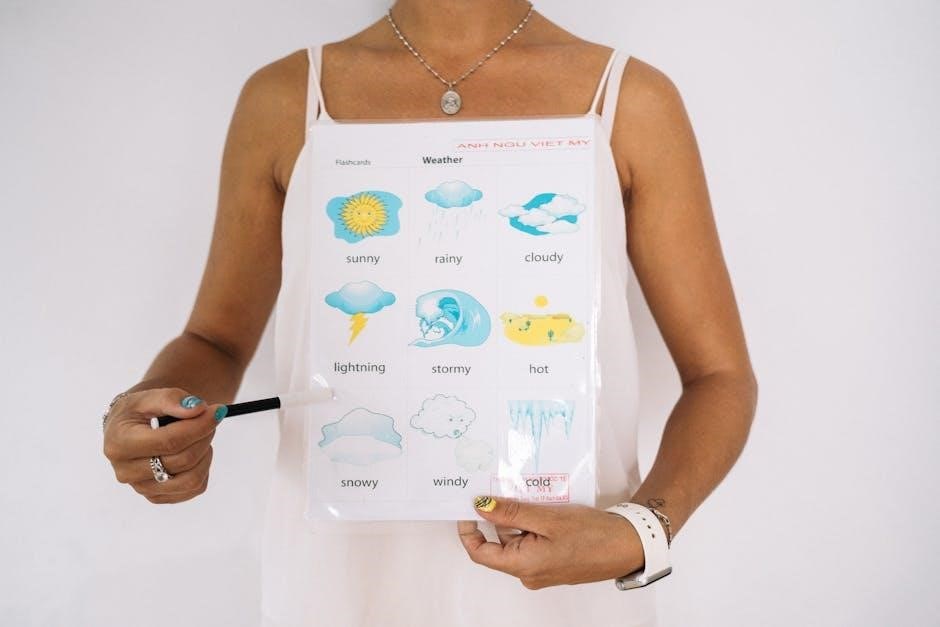The Science of Reading: Vocabulary Instruction
Vocabulary is a cornerstone of reading, directly impacting comprehension and fluency. The Science of Reading emphasizes explicit, intentional vocabulary instruction. This includes fostering word consciousness and teaching strategies for inferring word meanings from context. A robust vocabulary is essential for reading success.

Vocabulary’s Role in Reading Comprehension
Vocabulary serves as a critical foundation for reading comprehension. A reader’s understanding of individual words directly influences their ability to grasp the meaning of sentences, paragraphs, and entire texts. Research consistently demonstrates a strong positive correlation between vocabulary knowledge and reading comprehension skills across all developmental stages. A robust vocabulary enables readers to navigate complex sentence structures, understand nuanced language, and make inferences, all of which are essential for proficient reading.

The Science of Reading emphasizes the importance of vocabulary instruction in fostering reading comprehension. Without a sufficient vocabulary base, readers struggle to decode text effectively, hindering their ability to extract meaning. Therefore, explicit and intentional vocabulary instruction is crucial for equipping students with the necessary tools to comprehend written material successfully. By expanding their vocabulary, readers can unlock the meaning of texts and engage in deeper, more meaningful reading experiences. A rich vocabulary empowers readers to become active and engaged participants in the reading process, ultimately leading to improved comprehension and overall literacy skills.

The Connection Between Vocabulary and Reading Fluency
The relationship between vocabulary and reading fluency is intertwined and mutually reinforcing. While vocabulary primarily impacts comprehension, it also plays a significant role in facilitating reading fluency. A strong vocabulary enables readers to recognize words quickly and effortlessly, reducing cognitive load and allowing them to focus on the overall meaning of the text. When readers encounter familiar words, their reading speed and accuracy improve, contributing to smoother and more fluent reading.
Furthermore, a robust vocabulary enhances a reader’s ability to predict upcoming words and phrases, further accelerating the reading process. As readers encounter familiar words, they can anticipate the subsequent text, allowing for more seamless and efficient reading. Conversely, a limited vocabulary can hinder reading fluency, as readers struggle to decode unfamiliar words, causing them to stumble and slow down. The Science of Reading recognizes the symbiotic relationship between vocabulary and fluency, emphasizing the importance of developing both skills concurrently to foster proficient reading. By expanding vocabulary, readers can unlock greater fluency, ultimately leading to improved comprehension and overall reading proficiency. Fluent reading becomes a gateway to deeper understanding.

Direct and Intentional Vocabulary Instruction
Direct and intentional vocabulary instruction is a cornerstone of effective reading instruction, as emphasized by the Science of Reading. This approach involves explicitly teaching specific vocabulary words, rather than relying solely on incidental exposure. Teachers carefully select words that are both relevant to the curriculum and challenging for students, focusing on words that are likely to appear in future texts. The instruction goes beyond simply providing definitions; it delves into the nuances of word meaning, exploring synonyms, antonyms, and related concepts.
Furthermore, direct instruction incorporates activities that promote active engagement with the new vocabulary, such as using the words in sentences, creating visual representations, and participating in discussions. Intentional instruction ensures that students have multiple opportunities to encounter and use the new words in various contexts, solidifying their understanding and retention. Effective strategies include pre-teaching vocabulary before reading a text, explicitly teaching word parts (morphology), and providing ongoing review and practice. By implementing direct and intentional vocabulary instruction, educators can equip students with the robust vocabulary they need to comprehend complex texts and become proficient readers. This method fosters deeper understanding and usage.
Implementing a Weekly Vocabulary Routine
Implementing a weekly vocabulary routine is a highly effective strategy, supported by the Science of Reading, to enhance students’ word knowledge and reading comprehension. A consistent routine provides structured opportunities for students to learn, practice, and reinforce new vocabulary. This routine might involve introducing a set of carefully selected words at the beginning of the week, exploring their definitions, synonyms, antonyms, and using them in context.

Throughout the week, incorporate various activities that reinforce understanding, such as vocabulary games, word sorts, sentence writing, and discussions. A key element of a successful routine is regular review and assessment, ensuring that students retain the new words. Consider dedicating specific days to different aspects of vocabulary learning, such as Monday for introduction, Wednesday for application, and Friday for review. A well-structured routine not only expands vocabulary but also cultivates a deeper understanding of language and improves reading fluency. This systematic approach fosters long-term retention and builds a strong foundation for reading success. By making vocabulary a consistent focus, educators can significantly impact student literacy skills.
Teaching Vocabulary in Context
Teaching vocabulary in context is a crucial aspect of effective reading instruction, aligning with the principles of the Science of Reading. Rather than simply memorizing definitions in isolation, students learn words as they encounter them within the rich tapestry of texts. This approach enhances comprehension and fosters a deeper understanding of how words function in real-world communication. When introducing new words, teachers can encourage students to use context clues to infer their meanings. These clues might include surrounding words, phrases, or the overall theme of the passage.
Model how to identify and analyze these clues, demonstrating the process of making educated guesses about unfamiliar words. After inferring a potential meaning, verify it using a dictionary or other reliable source. This active engagement with the text promotes critical thinking and problem-solving skills. Moreover, discussing how the word’s meaning fits within the broader context of the passage helps students solidify their understanding. By consistently teaching vocabulary in context, educators empower students to become independent word learners, capable of deciphering unfamiliar words and expanding their vocabulary through reading.
Fostering Word Consciousness
Fostering word consciousness, a key component of vocabulary instruction rooted in the Science of Reading, cultivates an awareness of and genuine interest in words. It goes beyond rote memorization, encouraging students to become word detectives who actively explore the nuances and power of language. Teachers can ignite this curiosity by creating a classroom environment that celebrates words. Displaying interesting words, exploring their etymologies, and discussing their multiple meanings are effective strategies.

Encourage students to collect interesting words they encounter in their reading and share them with the class. Word games, puzzles, and activities that focus on wordplay can also enhance word consciousness. Furthermore, modeling enthusiasm for language is crucial. When teachers express their own fascination with words, it becomes contagious. By fostering word consciousness, we empower students to become lifelong learners who appreciate the richness and complexity of language, ultimately leading to improved reading comprehension and communication skills. This approach emphasizes a love for language, transforming vocabulary learning into an engaging and enriching experience.
Vocabulary Activities for Different Learning Environments

Vocabulary instruction, grounded in the Science of Reading, benefits immensely from diverse activities tailored to various learning environments. Whole-group instruction can incorporate interactive read-alouds with a focus on targeted vocabulary, encouraging choral definitions and contextual analysis. Small reading groups offer opportunities for differentiated vocabulary work. Students can engage in activities like concept sorting, where they categorize words based on shared attributes, or create visual representations such as word webs to illustrate connections.
Independent practice can involve vocabulary notebooks where students record new words, their definitions, and example sentences. Online platforms provide interactive vocabulary games and quizzes, catering to digital learners. Word sorts, matching games, and sentence completion exercises are also effective for reinforcing vocabulary acquisition. In blended learning environments, these activities can be seamlessly integrated, providing students with a comprehensive and engaging vocabulary learning experience. The key is to select activities that align with learning objectives and cater to the specific needs and preferences of the students, ensuring that vocabulary learning is both meaningful and enjoyable.

Strategies for Inferring Word Meanings
Effective reading comprehension hinges on the ability to infer the meaning of unfamiliar words. The Science of Reading emphasizes teaching explicit strategies for this crucial skill. Context clues are paramount; students should be trained to identify definitions, examples, synonyms, antonyms, and general explanations within the surrounding text. Modeling think-alouds, where teachers verbalize their thought processes when encountering unknown words, is invaluable. Encouraging students to ask themselves guiding questions—”What makes sense in this sentence?” or “Is there a word nearby with a similar meaning?”—fosters active engagement.

Analyzing word parts, such as prefixes, suffixes, and root words, provides additional insight. Explicitly teaching common affixes empowers students to decode unfamiliar terms independently. Furthermore, encouraging students to make educated guesses based on their prior knowledge and the overall context improves comprehension. After inferring a meaning, students should verify their understanding by substituting their inferred definition into the sentence and assessing whether it makes sense. Consistent practice with diverse texts and targeted feedback reinforces these strategies, enabling students to become proficient word detectives.
The Importance of Morphology in Vocabulary Acquisition
Morphology, the study of word parts (morphemes), plays a vital role in vocabulary acquisition and reading comprehension. Understanding prefixes, suffixes, and root words unlocks the meaning of countless unfamiliar words. The Science of Reading emphasizes explicit instruction in morphology as a powerful tool for decoding and comprehending complex texts. By learning common prefixes like “un-,” “re-,” and “pre-,” students can decipher the meanings of words like “unhappy,” “replay,” and “preheat.” Similarly, understanding suffixes like “-tion,” “-ness,” and “-able” helps students grasp the nuances of words like “completion,” “kindness,” and “readable.”
Root words, the core building blocks of words, provide further insights. Teaching common Latin and Greek roots, such as “port” (to carry) and “graph” (to write), empowers students to understand related words like “transport,” “portable,” “autograph,” and “biography;” Integrating morphology instruction into vocabulary lessons enhances students’ ability to independently infer the meanings of new words they encounter. This, in turn, fosters a deeper understanding of texts and promotes long-term vocabulary growth. Engaging activities, such as word sorts and morpheme charts, make learning morphology interactive and effective.
